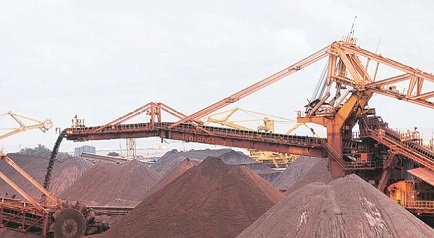By Our Correspondent
BHUBANESWAR: With COVID-19 positive cases are on rise in Odisha and the figure reached at 60 including 46 alone in State Capital of Bhubaneswar, the iron ore exports from this mineral bearing State is likely hit if the lockdown continues for more time, sources said on Wednesday.
Sources quoting GlobalData said iron ore exports from India are expected to decline by around 25% to 23.3 Mt in 2020 due to the coronavirus outbreak and the subsequent closure of ports, shortage of workers and transport restrictions, which are severely disrupting the exports as well as the domestic supply.
The auctioning of 21 iron ore mines was completed in February as their leases were expired in March 31. According to GlobalData estimates, out of approximately 25 non-captive iron ore mines, 22 were successfully auctioned, while three were put on hold over a pending legal suit from the Supreme Court of India.
The delays in mine auctions in Odisha, which were to be held in March of last year, due to the lack of clarity on the maximum lease area, will “severely damage” India’s iron ore output this year, which is expected to fall to 205.7 Mt, a 12.5% decline compared with 2019 (234.9 Mt).
The decline could have been over 40 Mt, had the Indian government not allowed new owners to start and continue operations until they had acquired fresh forest and environmental clearances, which could have taken up to three years.
Despite the decline in 2020, iron ore production in India is expected to grow over the forecast period (2020–2024) at a compound annual growth rate (CAGR) of 7.2% to reach 271.2 Mt in 2024. The resumption of operations at the auctioned mines will be a key factor behind this growth.
“Simultaneously, iron ore exports from India are expected to recover from the 2020 decline and post a forecast-period CAGR of 4.2% to reach 27.5 Mt in 2024, supported by improving demand from China,” sources said.
Meanwhile, Cargo handling in India’s 12 Ports under Ministry of Shipping 35.17 per cent in FY20 to 54.996 million tonnes (mt) from 40.687 mt in FY19, as miners in the eastern region liquidated their stocks at “whatever price they could fetch” before their permits ended on March 31 this year.
Paradip Port Trust benefited the most from this last-minute rush by miners to dispose of their iron ore stock before they surrendered their permits on completing the term.Paradip Port Trust handed 22.954 mt of iron ore in FY20, from 12.206 mt in FY19.Visakhapatnam Port Trust handled 14.386 mt of iron ore in FY20, from 10.242 mt in FY19.
Mumbai Port Trust handled 7.028 in FY 20 (7.266 mt), and New Mangalore Port Trust 4.989 mt in FY20 (4.624 mt). Kolkata Port Trust handled 3.179 mt of iron ore, against 4,74,000 tonnes in FY19.“The growth in iron ore volumes at Paradip Port Trust was due to both coastal movement as well as exports,” sources said in Paradip in Odisha.
The coastal movement was led by the JSW Group, which shipped the steel-making commodity from its mines in the East to Mumbai, for use by Dolvi Steel Plant.“Substantial volumes of iron ore were exported to China by entities such as B S Minerals, Essel Mines, Rungta Mines, S M Niryat and Kashvi International,” he said.
The surge in iron ore shipments helped Eastern coast ports such as Paradip, Visakhapatnam, Dhamra and Gangavaram to deliver strong volume growth in FY20.
However, ports such as New Mangalore and Mormugao suffered due to the ban on export of the steel making commodity from Karnataka and Goa.Mormugao reported a drop in iron ore loadings to 1.710 mt in FY20 from 4.181 mt in FY19.
With this, Iron ore, including pellets, handled by the 12 state-owned ports, jumped 35.17 per cent in FY20 to 54.996 million tonnes (mt) from 40.687 mt in FY19, as miners in the eastern region liquidated their stocks at “whatever price they could fetch” before their permits ended on March 31.
The iron ore loadings, in fact, helped these 12 ports, which have a market share of about 55 per cent of India’s external trade shipped by the sea route every year, to sail past combined volumes of 699.10 mt recorded in FY19.
The dozen ports ended FY20 with a total volume of 704.822 mt, notching a paltry growth of 0.82 per cent over FY19.
Apart from iron ore and finished fertiliser shipments, which grew by 12.69 per cent to 9.305 mt (8.257 mt), no other cargo segment posted double digit growth in FY20.
Thermal and steam coal, the other main cargo shipped through the dozen ports, declined 12.72 per cent to 92.410 mt in FY20 from 105.880 mt in FY19.
The Federation of Indian Mineral Industries, a lobby group, estimates that 137 mt of iron ore were lying at the mine heads located in Odisha and Jharkhand in April 2019, of which 85 mt were in Odisha alone.



























